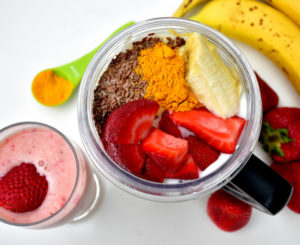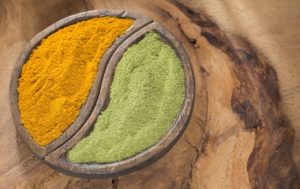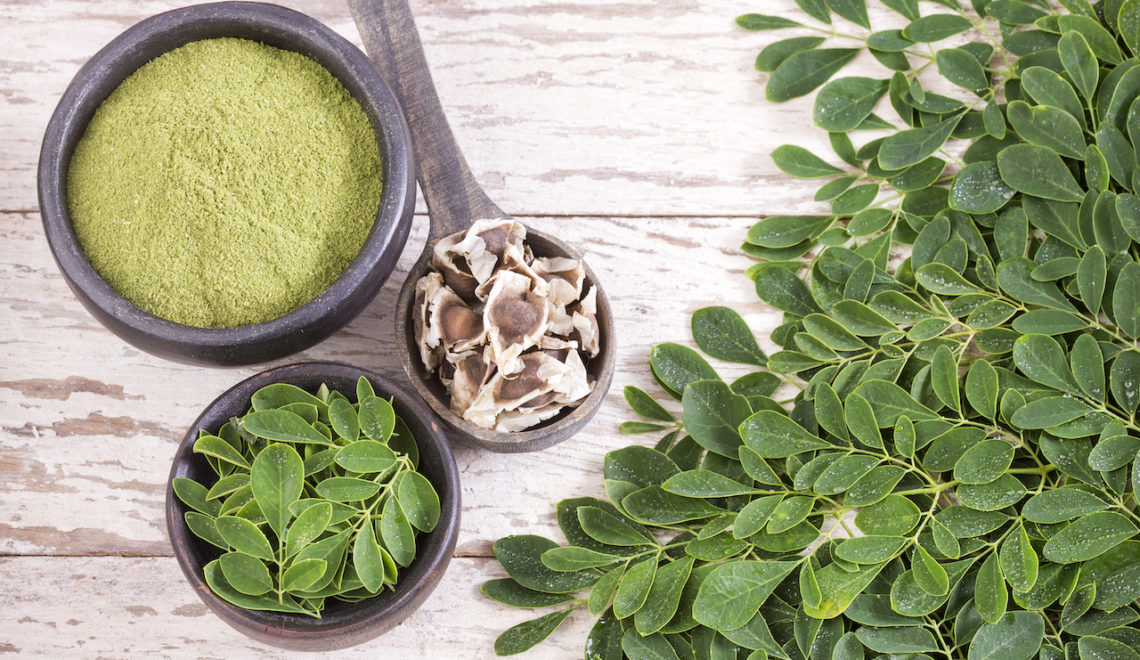While you may have only seen the word “moringa” in the last few years, how much do you know about it? How does the superfood moringa compare to other superfoods like turmeric? Turmeric is often used for conditions involving pain and inflammation, and moringa can also help with inflammation.
Moringa vs. Turmeric: A Recap
Morina has been showing up strong in the Battle of the Supergreens, a lively series where we compare superfoods with each other. Both moringa and turmeric are really healthy additions to your diet. We recommend a Moringa Turmeric Smoothie after reading this article!
Superfoods and Inflammation
Inflammation is more than a sprained ankle or scraped knee. It can happen to any tissue in the body. Through inflammation, our body communicates that something is amiss. And food does play a role in how our bodies respond to inflammation. For a more in-depth read on anti-inflammatory foods, we have articles on that too.
Moringa’s anti-inflammatory prowess has been somewhat overshadowed by the relative popularity of another superfood… turmeric. As an anti-inflammatory, moringa may be more effective at reducing inflammation than turmeric.
There are already more than enough reasons to make moringa a regular part of your diet. To give a quick snapshot, moringa has twice the protein, three times the calcium, and four times as much iron as kale. Beyond these amazing nutritional properties, research is now pointing to the fact that moringa should be your anti-inflammatory of choice.
But just how strong of an anti-inflammatory is moringa? We decided to compare it to turmeric in an anti-inflammatory battle royale
Comparing Anti-Inflammatory Superfoods
Before we compare the anti-inflammatory properties of two different foods, we must first understand how the foods actually reduce inflammation. Turmeric is a root, related to ginger, and is used in food and cooking. Its principle anti-inflammatory compound is a curcuminoid phenol compound known as curcumin. Curcumin is also what gives turmeric its yellow color.
Moringa is similar to broccoli in that it is a cruciferous vegetable and contains glucosinolates that can form isothiocyanates. Isothiocyanates can also be found in cruciferous vegetables like broccoli and kale. Isothiocyanates are readily absorbed in the body and have been well-studied in broccoli.
Emerging research on moringa has shown that the isothiocyanates in moringa are even more stable and bioactive than those found in broccoli. These compounds reduce inflammation by reducing the production of nitric oxide (NO) and inflammatory markers. Additionally, they are able to activate a detoxification pathway known as Nrf2.
A recent study found that the isothiocyanates were more effective at reducing inflammation markers than curcumin. In the test, Curcumin reduces nitric oxide (NO) production by 5-30% while similar concentrations of moringa isothiocyanates reduced NO by 72-93%. Moringa was also more effective at reducing concentrations of three different inflammatory markers including iNOS, IL-1β, and IL-6.
Turmeric is not Readily Absorbed
Turmeric is not as easily absorbed when eaten on its own, which brings to question its bioavailability. One of the best ways to solve this problem is to eat turmeric in conjunction with black pepper. Black pepper contains an alkaloid called piperine, which significantly boosts the body’s ability to absorb turmeric. However, this can be a hassle as it takes a few hours after consumption for piperine’s effects to peak.
Additionally, if you don’t have the time to eat pepper in advance, there aren’t many cases in which black pepper and turmeric go well together. Finally, despite turmeric’s popularity as an anti-inflammatory, there isn’t enough research that has proven clinically the anti-inflammatory effects of curcumin.
Moringa has Higher Bioavailability
Isothiocyanates may be more bioactive and easily absorbed in the body than curcumin. No need to worry about pre-gaming your moringa with pepper because your body can absorb it all by itself. Moringa also gives you a host of other health benefits beyond what your typical green vegetable is capable of providing. This is in part because while most greens are 90% water, moringa is only 80% water, making it more nutrient-dense than most leafy greens.

Anti-Inflammatory Smoothie, anyone?
Of course, this isn’t to say turmeric isn’t good for you (it is a superfood after all). However, in terms of anti-inflammatory foods, moringa may be a simpler and more versatile ingredient to add to your anti-inflammatory lifestyle. If you’re looking for a natural solution to reducing inflammation, add moringa to your favorite smoothies, shakes, and any sweet or savory dish.
It’s just one more reason to eat moringa every day as part of a healthy diet. Still not convinced? Eating moringa can also help reduce blood sugar and bad cholesterol.
Check out our Moringa Anti-Inflammatory Smoothie or the vast offering of #MoringaInspired recipes and smoothies on our website. Because of moringa’s versatility, you can use it to improve the nutritional quality of so many meals. Try moringa in a bar, as an energy shot, or in our new moringa greens and protein powder!
For more information on moringa’s health benefits, check out Kuli Kuli’s popular Battle of the Greens series below!
Kale vs Moringa
Matcha vs Moringa
Spinach vs Moringa
Collard Greens vs Moringa
Swiss Chard vs Moringa
Kelp vs Moringa
Spirulina vs Moringa
There you have it! A bit of the nutritional details behind moringa and turmeric, revealed.
Don’t forget to tag @kulikulifoods in any social media posts you share so we can see your beautiful creations!
References
Graf, Brittany L., Asha L. Jaja-Chimedza, and Ilya L. Raskin. “Comparative Anti-Inflammatory Effect of Moringa-Derived Isothiocyanate versus Curcumin in vitro and in vivo.” The FASEB Journal 31.1 Supplement (2017): 972-22.
Juge, N., R. F. Mithen, and M. Traka. “Molecular basis for chemoprevention by sulforaphane: a comprehensive review.” Cellular and Molecular Life Sciences 64.9 (2007): 1105.
Jurenka, Julie S. “Anti-inflammatory properties of curcumin, a major constituent of Curcuma longa: a review of preclinical and clinical research.” Alternative medicine review 14.2 (2009).
Laurence, Emily. “This Super Green Is a Stronger Anti-Inflammatory than Turmeric.” Well+Good, 12 Sept. 2017, www.wellandgood.com/good-food/health-benefits-of-moringa/.
Maheshwari, Radha K., et al. “Multiple biological activities of curcumin: a short review.” Life Sciences 78.18 (2006): 2081-2087.
Menon, Venugopal P., and Adluri Ram Sudheer. “Antioxidant and anti-inflammatory properties of curcumin.” The molecular targets and therapeutic uses of curcumin in health and disease. Springer US, 2007. 105-125.
Tumer, Tugba Boyunegmez, et al. “Direct and indirect antioxidant activity of polyphenol-and isothiocyanate-enriched fractions from Moringa oleifera.” Journal of agricultural and food chemistry 63.5 (2015): 1505-1513.
Waterman, Carrie, et al. “Stable, water extractable isothiocyanates from Moringa oleifera leaves attenuate inflammation in vitro.” Phytochemistry 103 (2014): 114-122.













While you do make many valid points and overall the favor does seem to be yours, the point I wish to make is the price point. Turmeric itself is inexpensive and even the addition of black pepper does not drive the price point up much. Moringa is substantially more expensive. You can get a lot of turmeric and black pepper for what can be spent on Moringa.
That being said, I do have a great fondness for Moringa in all of its forms.
The price doesn’t concern me, but I wish the company hadn’t ruined the bars by adding sugar. Any health benefits of the Moringa is more than offset when I see cane Sugar on the ingredient line. Stevia anyone???
Stevia is not good for you
Here in the philippines we are rich in moringga..Moringga tree grows everywhere.Unlike turmeric and pepper, it is expensive here.
I make moringga powder and sell it..because we have lots of it.
I love Moringa which is very new in my country, Papua New Guinea. Moringa grows well in India and African countries….PNG is no different.
KuliKuli must come to PNG.
You mentioned assisting developing countries, PNG is one of those countries……Are you interested, I am also expanding to the rural areas to grow more Moringa. Creation of employment fot women, girls boys. Income generating project. And your presence is a mighty boost….PNG issues , Malnutrition, Diabetics, Cancer, High Blood pressure, etc. Again you can make a big difference . Two can go a long way not one.
Thank you.
Thank you for your interest. We have very strict sourcing standards. Please provide a detailed inquiry via our contact us page.
Moringa excellent product
We think so too! Thanks for reading!
Hi Dave,
Great work and througout in providing this information. I’m a big fan of curcumin myself, but nobody seems to know what absorbent agent is really the best. There seems to be a lot of discussion about it, but as a newbie in this field, i’d like your opinion on this.
I’ve also read different studies, but they are mostly provided by the manufacturiers or somebody associated with their product.
Do you know which absorbent agent is the best for curcumin?
thanks in advance.
Kind Regards,
Edwin
Hello Dave,
This is an interesting read about Moringa. Thank you!
I am a great fan of turmeric and black pepper. I had pain in my knees and was diagnosed with osteoarthritis a couple of years ago, and was prescribed medication. The side effects were many and knowing the end result of this condition, I stopped the medication and switched to turmeric and black pepper. The absorbing agent is black pepper. It’s over two years since I started with this capsule, and I am fine. Very less or no pain at all. I can walk, climb without any difficulty.
Now I am keen to know whether I should switch to Moringa, or I don’t even mind taking it together?
this is very confusing for me to think about …… in general all I want to know which one turmeric or moringa has the better benefits for your body …….. I dont need all this other stuff just a simple answer which one of the 2 is better for your body ??????????????????
I live in Thailand. Both products are very easy to come buy here. But the Moringa powder has only recently become a thing here as Moringa leaves and pods are common in a variety of our foods.
I take both Moringa and Tumeric. One in the morning, the other at night.
Tumeric with black pepper absorbs best when taken with a natural fat, coconut oil, milk,etc.
If you read the blog carefully, Moringa has more positive words than turmeric.
CAN I use moringa powder as tea .
And also how should I use it for building muscle.
Pls can I combine moringa and tuner ic together
Thanks
Yes you can use moringa for tea! They have a few recipes on the blog you can follow and Moringa Tea products you can purchase from the website!
I take Turmerynne and Moringa capsules twice a day. Is it safe to do this? I’m not going to overdose and cause more harm than good am I?
Hey Sharlene, thanks for your question! It’s important to look at the dosage in each supplement, and also confirm with your doctor that it is an okay dosage and combination. In general, 5-10 mg/day is a good amount to take of moringa capsules. A daily serving of 5-10 grams of moringa is a safe amount as a good, general practice. For more than that, it’s best to check with your doctor. Hope this helps!
Great comparison between the two. Turmeric is an ancient superfood that can also do a lot of good for the body
Had you heard that website contact page messages like this one can actually be a great way to get more sales for your business? How exactly is this done? Easy peasy, we craft an ad message like this one for your site and we mass post it to tons of contact pages on any kind of website you want. Does this method of advertising work? Since you’ve ready my entire message then you’re proof that they do! What’s more, this won’t cost you much more than a cup of coffee a day! Want more info? write an email to: UlisesDonaldsoni4472@gmail.com
Thanks for sharing this well-researched article on Turmeric and Moringa. I learned a lot about Turmeric and Moringa from another blog but in this comparative way. I will add your blog to my list.
Keep Posting great stuff!